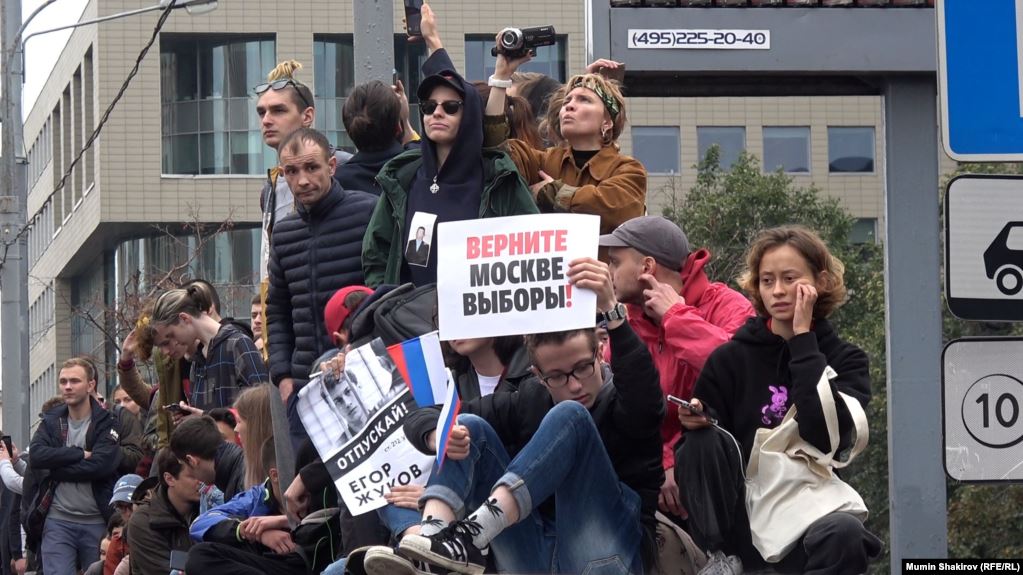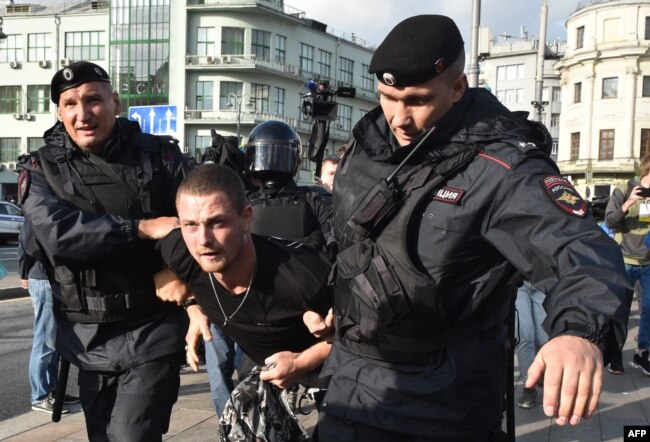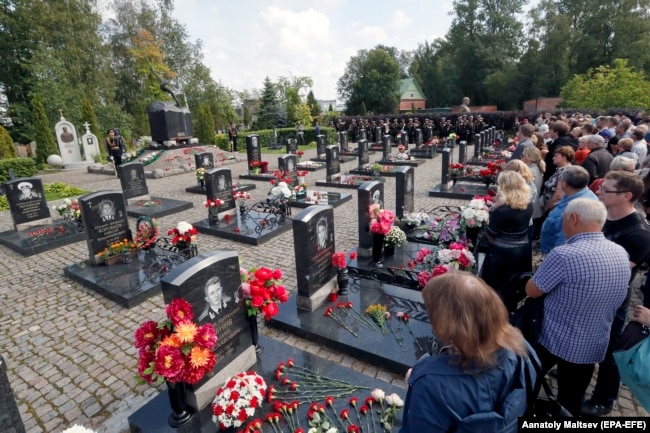
By Margarita Assenova, for Polygraph
Using non-information as a disinformation tool is not a new tactic for the Kremlin. But the Russian government’s attempt to hide information about the large opposition protests in Moscow and the explosion of a nuclear-powered missile in the White Sea has misfired in the era of social media, which the Kremlin cannot fully control.
As the images of brutally beaten and arrested protestors in Russia were circulating around the globe, the Kremlin made a doomed attempt to hide the large anti-government demonstrations in Moscow, St. Petersburgh, and other major cities from its own public and the world. On August 11, after approximately 60,000 people rallied in Moscow to protest the exclusion of opposition candidates from the upcoming municipal elections, the Russian government media watchdog, Roskomnadzor, demanded that the U.S. company Google stop the “advertising of unauthorized (illegal) mass events on the company’s video hosting channel YouTube.”
Two days earlier, the Russian Foreign Ministry summoned the U.S. diplomat who had posted a routine warning for American citizens to avoid the streets where the demonstrators were gathering. The ministry said it regarded the protests’ route map, published on the U.S. embassy Twitter account, as “an act encouraging participation and a call to action, which constitutes an attempt to interfere in Russia’s domestic affairs.”
As evidence Zakharova cites the US embassy’s publication of the route protesters planned to take through Moscow & claims it encouraged people to attend. She seems to be citing this warning, which specifically urges US citizens NOT to go. HT @Mike_Eckel https://t.co/auE63WttS7
— Matthew Luxmoore (@mjluxmoore) August 5, 2019
On August 5, Moscow accused Deutsche Welle (DW) of urging Russians to participate in the opposition protests and warned the government-funded German broadcaster that it would take action against it under Russia’s domestic law if it made such calls again.
Foreign Ministry spokeswoman Maria Zakharova claimed that, “The official social media channels of DW’s Russian service were being used to call for mass participation in illegal protests.” DW rejected the allegations, saying they were related to the brief arrest of its correspondent Sergey Dik on July 27, one of the reporters detained while covering an opposition rally in Moscow as the police violently cracked down on protesters.
In addition, Russia’s State Duma (the lower house of parliament) Council decided to hold a special meeting on August 19 to discuss foreign interference in the country’s domestic affairs “by a number of foreign media outlets and diplomatic missions, particularly during a recent unauthorized rally in Moscow.”
The ruling United Russia party’s parliamentary faction in the Duma has already warned that foreign media outlets interfering in Russia’s affairs, particularly through publications concerning the recent unauthorized rallies in Moscow, may be barred from working in the country.
The Russian authorities claim that information about the weekly protests in Moscow and the brutal response by the Russian security forces spread mostly through digital social networks and foreign media outlets. That claim is accurate. But this is mainly because the majority of Russia’s media outlets, which are either controlled by the Kremlin or owned by oligarchs loyal to Russian President Vladimir Putin, barely reported on the demonstrations or provided distorted coverage meant to discredit the opposition.
Polygraph.info’s William Echols found out that Russian state TV channel Rossiya-1 ran a hit piece on the August 10 opposition rally in Moscow claiming the march was masterminded and orchestrated from abroad by Russia’s enemies.
Rossiyskaya Gazeta published reports diminishing the protests or focusing on how they affected local businesses such as restaurants and hotels.
RFE/RL reported that the publication ran a photo report of the rally showing demonstrators as people with tattoos, fans of Mikhail Khodorkovsky, or allegedly supporting Ukraine and LGBT rights.
Public disdain of the Russian media such as NTV, the once independent TV channel that is now controlled by the Russian state oil and gas giant Gazprom, was obvious in this picture of an NTV van turned into a rubbish bin by protestors.
В Москве, автомобиль “НТВ” превратили в “мусорное ведро”. pic.twitter.com/IjICETku5f
— Umar (@Umar20946390) August 10, 2019
At the same time, the police prevented the few still standing Russian independent media outlets from reporting on the protests. Many journalists were harassed, beaten up and arrested by the security forces, which the Kremlin sent to crack down on the demonstrations. The Committee to Protect Journalists (CPJ) strongly condemned the detention of 20 journalists on July 27 and August 3, and harassment of others during the protests. CPJ listed the names and affiliations of all Russian journalists subjected to police brutality.
Hiding the Nuclear Reactor Explosion
The demonstrations in Moscow and other major cities were not the only events the Kremlin wanted to cover up with non-information last week. The Russian authorities also blocked for five days information on the explosion of a nuclear reactor on August 8 at a military test site near Severodvinsk, in the Arkhangelsk Region.
Explosion in Nenoks (NNKS) at the military test site 45 of the Navy named after Lenin. It was created in 1954.Code designation: “zero-nine”.Appointment: missile tests … Isakogorka -Nenoksa branch of the road. Dvina Bay and the White Sea section is closedhttps://t.co/ZEI94RbgwD pic.twitter.com/VIPUOCXysE
— Наталья Ярославова-Оболенская (@lebed_60) August 8, 2019
Even as the Kremlin announced that the five nuclear scientists who died in the accident had been awarded the Order of Courage, the Russian state news agency TASS still claimed they died in a liquid propellant engine blast.
The Russian Defense Ministry initially said the incident on August 8 involved a liquid propellant engine at a military test site near Severodvinsk. According to TASS, two days later, the Russian State Nuclear Energy Corporation, Rosatom, said that a fire and an explosion had occurred during a missile test on a sea platform, killing five workers and leaving three others injured.
Not a word about the nuclear reactor that exploded. Rosatom’s obscure scientific language of “radio-isotope propellant source” (meaning a nuclear-powered reactor) was not even mentioned by the state news agency.
A top official at the Russian Federal Nuclear Center, where the five dead scientists worked admitted in a video on local TV that the failed missile test involved a small nuclear power source, Bloomberg reported. He said that the Center was developing small-scale power sources that use “radioactive materials, including fissile and radioisotope materials” for the Defense Ministry and civilian uses.
And although local residents bought out all available iodine supplies in the region’s pharmacies, information about increased levels of radiation in the area was absent. In fact, the initial warning of radiation spike was taken off the Severodvinsk administration’s website, with the explanation that the issue pertained to the defense ministry. Until the Russian weather service reported on August 14 that radiation near the site of the deadly explosion had spiked 16 times above normal for an hour and half following the explosion.
Old Strategy, New Environment
Moscow’s non-information strategy is very similar to that of the Soviet Union: it operates on the premise that if there are no media reports, nothing happened. It has been used numerous times in Soviet history.
This was the case in April 1986 when the Soviet regime prevented the spread of information on the Chernobyl nuclear explosion in order to deny that it ever happened — until the radioactive clouds spread over Europe.
It was also the case when the Soviets banned accurate information about the Gulag for decades — until former prisoners defected to the West and released their memoirs.
Most recently, the Kremlin hid information about the Kursk nuclear submarine disaster in August 2000 – until information leaked out that 118 mothers had to bury their sons.
The Kremlin’s non-information as disinformation strategy has rarely been effective for long, because the truth comes out sooner or later. The key to Soviet propaganda was delaying the information as much as possible to prevent immediate domestic or international reaction and allow Moscow time to prepare a response.
But in the age of social media the non-information strategy no longer works and often misfires. The Russian government seems unprepared to deal with the rapid spread of information through social channels, accompanied with the indisputable evidence of pictures and videos, and garnished by the angry comments of Russian citizens. The protests against the barring of opposition candidates from the upcoming local elections in September have only grown larger, reaching the reported figure of almost 60,000 in Moscow on August 10, and have spread to St. Petersburg and 40 other cities in Russia.
And while the Russian government is increasing its efforts to establish control over the Internet at home, a recent study by the Moscow-based Levada Center suggests that the Kremlin is losing its grip on the media in Russia. The study indicates that although television has remained the main source of news, its popularity has dropped from 94 to 72 percent. More importantly, younger Russians are increasingly turning to independent news websites and social networks as sources of news about the world and their own country.
The Kremlin, which has successfully used Facebook and Twitter to meddle in other states’ elections and internal affairs, is now experiencing the power of the digitalized social web at home. It is utilized by Russian citizens in confronting a government that not only denies them democratic choice in elections, but also hides important facts about their own country.
By Margarita Assenova, for Polygraph



![Russia -- Protesters hold a poster reading "Free [jailed student] Kirill Zhukov!" during a rally in central Moscow on 10Aug2019](https://gdb.polygraph.info/2A3DB9BB-A735-4131-A529-4A577F31AB8E_w650_r0_s.jpg)






